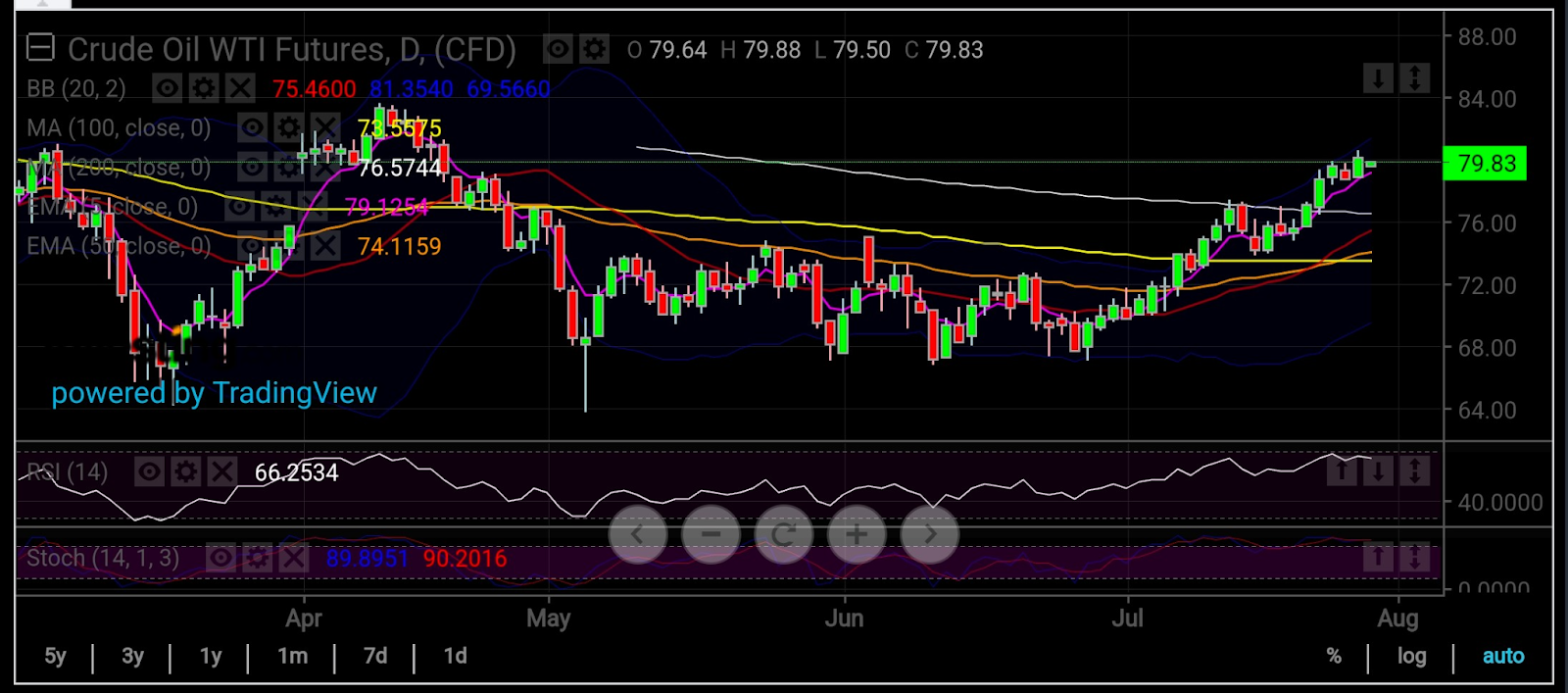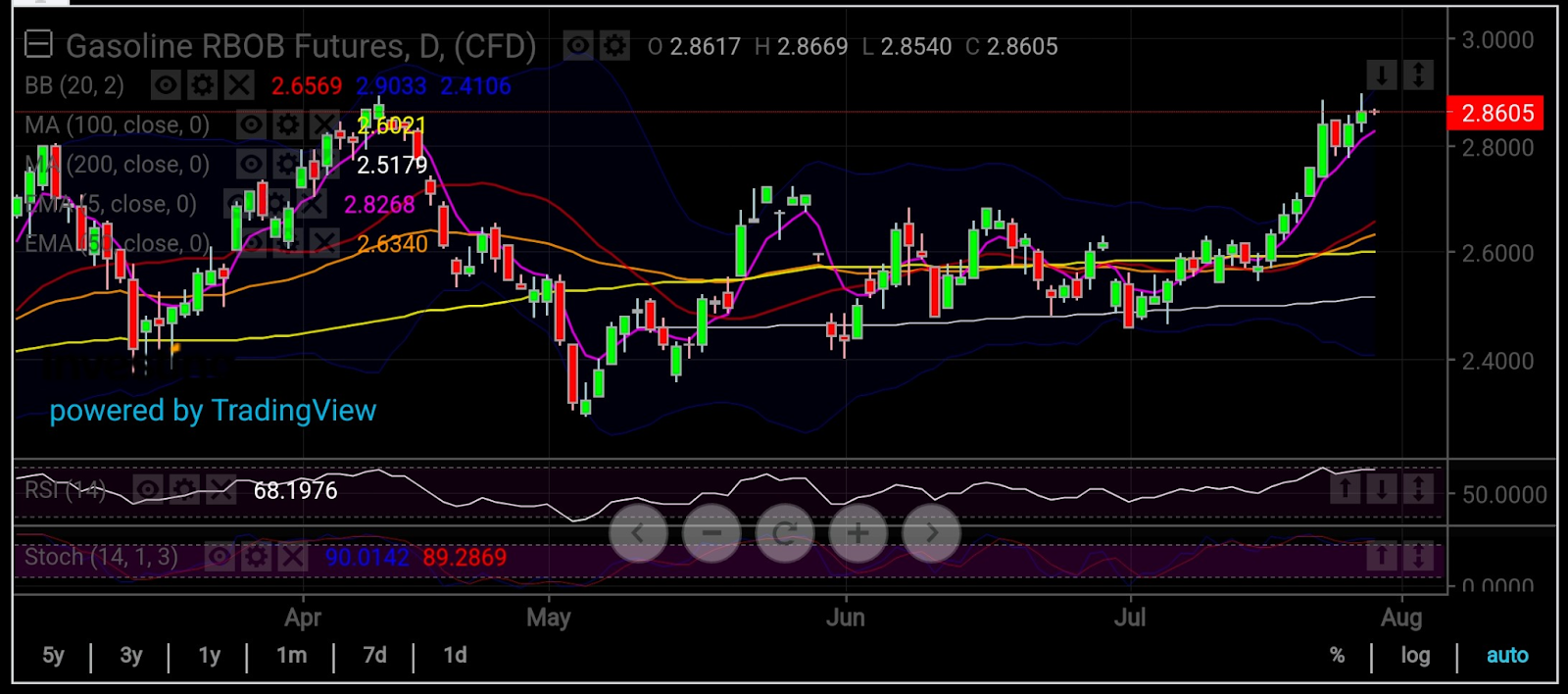- July’s double-digit rally in oil could continue, fundamental and charts show
- Yet, threat of inflation grows as a barrel of crude, gasoline get costlier
- Fed likely to fight back with higher rates, risking economic growth
Back in June, I wrote that in a perfect world, oil would be at $80 a barrel then itself, $90 in July and $100 by August. Well, it’s taken a little longer to get both U.S. crude and global benchmark Brent moving appropriately higher. But it’s still not a perfect world by any means, because this new rally in oil might worsen an old problem: inflation.
From below $67 a barrel in June, U.S. crude’s West Texas Intermediate, or WTI, matched an April high of $80.61 on Thursday. Brent went from sub-$72 last month to a three-month high of $84 in the past 24 hours.
If that momentum keeps up — there’s not much immediate reason why it won’t — crude prices will finish higher for a fifth straight week in a run that has already delivered as much as 13% to the pocket of oil bulls for July.
And with oil producers in OPEC chanting non-stop about the supply cuts that group leader Saudi Arabia was supposedly making; the U.S. economy appearing to have grown far beyond forecast in the quarter — and Americans filing fewer unemployment claims each week despite moderating jobs growth — the rally could have some way to go fundamentally.
All charts by SKCharting.com, with data powered by Investing.com
Technically as well, WTI might not hit serious resistance until $86, charts suggest.
“Holding above the 5-day EMA of $79.10 is a precondition for continuation of current bullish momentum,” Sunil Kumar Dixit, chief technical strategist at SKCharting.com said, referring to the Exponential Moving Average.
He said the next immediate target of oil longs would be the 100-week SMA, or Simple Moving Average, of $85.30 and the monthly Middle Bollinger Band of $86.40
“These two levels are likely to act as the resistance zone in mid-term,” added Dixit.
The popular saying about the demand for oil is that it is inelastic to price. To put it simply, regardless of how expensive it gets, people will still have to drive, fly and operate machinery and these activities all consume oil.
To hear the narrative from the glowing perspective of oil bulls, U.S. crude supplies are about 7% below the five-year average for this time of year and based on current demand levels, are at their tightest levels in over a year. Never mind that for two weeks in a row, the Washington-based Energy Information Administration, or EIA, has reported lackluster drawdowns from U.S. U.S. crude stockpiles despite the Saudis vowing that they were cutting a million barrels per day on top of other OPEC reductions.
Oil bulls also go by the statistic that total petroleum product demand in the United States increased by 1.1 million barrels per day last week to a new peak of 32 million barrels a day.
The other side of the tale is that the EIA reported a gasoline inventory draw of just 0.786 million barrels last week, versus a forecast decline of 1.678 million barrels and the previous week’s drop of 1.066 million. Automotive fuel gasoline is the No. 1 U.S. fuel product.
Finished motor gasoline products delivered to the marketplace — an indication of demand at the pump — stood at 8.855 million barrels versus the prior week’s 8.756 million. Typically, at this time of year, more than 9.0 million barrels of gasoline or more are supplied to the market each week.
In the case of distillate stockpiles, the EIA reported a drop of 0.245M barrels. Analysts had forecast a decline of 0.301M barrels last week, against a previous drop of 0.014M. Distillates are refined into heating oil, diesel for trucks, buses, trains and ships, and fuel for jets.
Aside from actual consumers of fuel, a chunk of the demand for energy comes from the trading or buying of futures by merchants, banks and individuals looking to profit without taking delivery of the product. Often, in an oil rally like now, the speculative, investment or trading interest drives the price more than actual consumption.
Notwithstanding all these, two things could ultimately decide the price of oil.
The first is the purchasing power of its biggest consumers — comprising not just Americans and Europeans but also Asians who are among the largest customers of Saudi crude.
The other thing that will challenge the rally is the resolve of central banks — chiefly, the Federal Reserve — which will not want to lose the progress made over the past 18 months in fighting the worst inflation in four decades. The higher the oil price goes, the more determined the Fed will be to use the best weapon it knows against inflation: interest rates. If the central bank starts an all-new aggressive money-tightening regime, that would not be too good for the economy — and the oil demand that rides on it.
Despite the so-called inelasticity of oil demand to price, demand destruction does set in when oil gets simply too ridiculously expensive for the average consumer. WTI at $80 a barrel might not make too much of an impact compared to $75 or even $70. But try $90 and you might start witnessing lower consumption in weekly data issued each week by the U.S. government.
It wasn't always like this though. A decade ago, oil was at $100 a barrel or around there. Then U.S. inflation was at its previous perma low of 2% or below as service and goods producers strove to keep costs low and consumers happy. The pandemic of 3 years ago however changed everything. Faced with supply disruptions and higher material cost in almost everything, producers began charging more — and developed a liking for it when consumers paid without resistance. A new era of inflation was thus born.
Now, if oil goes back to $100, it will pull up inflation appreciably — not like before. We saw how quickly prices recoiled from 14-year highs of around $140 after the Russian invasion of Ukraine last year. That's what's called demand destruction.
Perhaps the most impactful number on oil now is the one not reported by the EIA but by the American Automobile Association, or AAA: the daily, weekly and monthly change in the fuel price at U.S. pumps.
That was a new high for the year and due partly to refinery outages that had blown out the gasoline crack — or the profit from refining crude into motor fuel — to a 2023 high of $42. Diesel cracks hit nearly $40.50 with diesel supplies said to be at 14% below the five-year average and globally well below the 10-year average
The Wall Street Journal, in reporting the higher U.S. pump prices, pointed out that retail gasoline was a key factor in pushing June 2022 overall U.S. Consumer Price Index to a 40-year high of 9.1%. High fuel prices eventually forced companies to hike prices on everything from food to appliances and other household goods.
Dixit, the technical analyst at SKCharting.com, says gasoline futures, which form the base price of the gasoline crack, were likely to stay higher so long as a gallon remained above the $2.73 support:
“Continuation of the current bullish momentum is likely to extend the upward move towards the next resistance of $3.02.”
Phil Flynn, energy analyst at Chicago’s Price Futures Group and an avowed oil bull, interestingly challenged the Fed in his column on Thursday to try and fight the new inflation threat coming from oil.
“Is the Fed going to go back to watching pump prices? They had better,” he wrote.
***
Disclaimer: The content of this article is purely to educate and inform and does not in any way represent an inducement or recommendation to buy or sell any commodity or its related securities. The author Barani Krishnan does not hold a position in the commodities and securities he writes about. He typically uses a range of views outside his own to bring diversity to his analysis of any market. For neutrality, he sometimes presents contrarian views and market variables.
